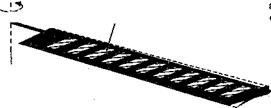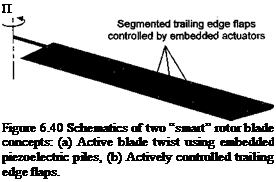Smart Rotor Systems
A “smart” structure is one that involves distributed actuators and sensors, along with a computer to analyze responses and apply displacements or strains to change the characteristics of the structure in an adaptive and beneficial way. Smart structures make it possible to aerodynamically alter the properties of rotors in a desirable way so as to reduce vibrations, improve performance, and enhance other performance factors. Such alterations would include the use of actively controlled aerodynamic surfaces on the rotor, such as with trailing-edge flaps (Fig. 6.40) or an all-movable blade tip or with strain producing actuators embedded in the blade to create elastic deformations. The field is reviewed by Chopra (1997, 2000). While the technology is not yet mature, various concepts are developing quickly, and it is likely that a full-scale helicopter rotor incorporating one or more new smart technologies will fly early in the twenty-first century.
Much of the work in this field has so far focused on building and testing dynamically scaled smart rotor models. The actuation concepts are presently difficult to build at full-scale without excessive weight and power penalties, but this will change as further research is conducted. Many of these rotor models consist of controllable twist blades, incorporating embedded piezoelectric elements or trailing-edge flaps (Fig. 6.40), actuated by piezoceramic or magnetostrictive actuators. The performance of the actuation systems seems to be degraded dramatically at higher rotational speeds because of high dynamic pressure, centrifugal forces, and frictional moments on the actuation mechanisms. For trailing-edge flap designs, a compact torsional actuation technique is required, and several approaches have been examined. For controllable twist designs, banks of piezoceramic elements are embedded under the skin of the blade on the top and bottom surface. To induce sufficient
(a) Active blade twist rotor concept
; Q Active piezoelectric piles embedded in blade
![]()
![]()
 /— structure to generate torsional twisting L" / about the elastic axis of the blade
/— structure to generate torsional twisting L" / about the elastic axis of the blade
 |
axis
blade twist for active control of rotor vibration or noise, a large number of distributed piezoceramic elements are required. Although this system involves no moving parts, it incurs a significant weight penalty and gives an undesirable increase in blade stiffness. There are also structural integrity issues.
Straub (1995) and Straub & Merkley (1995) have carried out a feasibility study of using smart structures technology for primary as well as active control of a full-scale helicopter rotor. It was concluded that the concept of blade twist and profile camber control using embedded actuators is not practical with the types smart materials currently available. Servoflap control systems using on-blade smart material actuators appeared conceptually feasible for primary and active controls. Shen et al. (2003) have examined the idea of trailing edge flaps for the primary flight control of an ultralight helicopter. So far there has been limited research towards the development of analytical tools need for a smart rotor design. Recently, however, there has been some effort to develop a coupled actuator-flap – rotor dynamic analysis, but it is far from being as comprehensive as would be required for confident design use. The development of unsteady aerodynamic models for this purpose have also undergone substantial development – see Section 8.18 – and the proper modeling of unsteady aerodynamic effects is vital to the predictive success of analytical tools for smart rotor systems. While it is clear that the smart rotor technology is not yet mature, either from a theoretical or practical perspective, various concepts are developing quickly and it is likely that a full-scale helicopter incorporating one or more of these technologies will fly within the next few years. It would seem, however, that full flight certification of actively controlled rotors for use in production helicopters is a longer way off.











